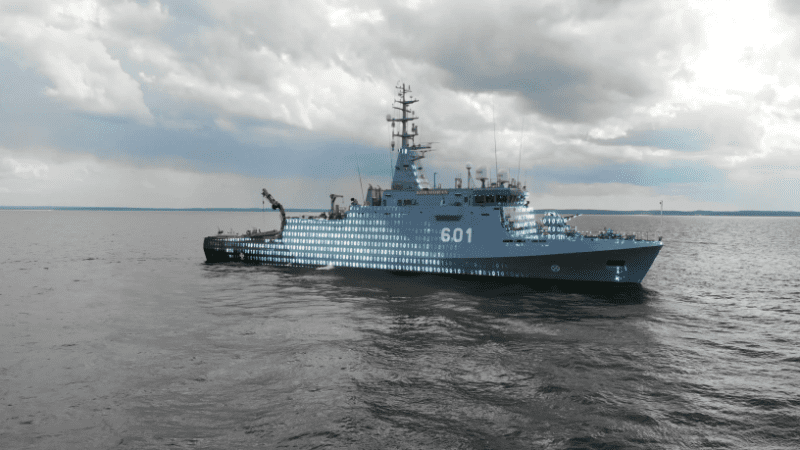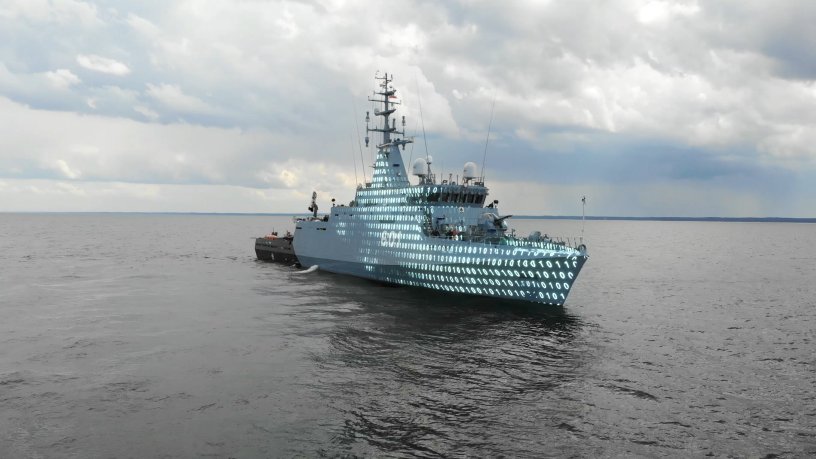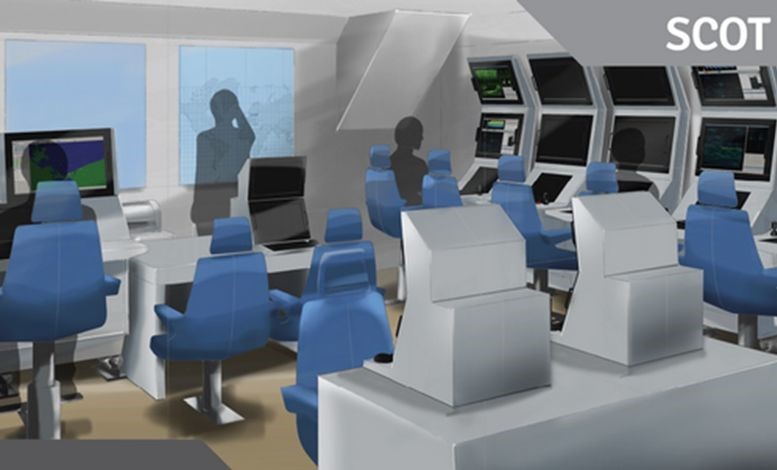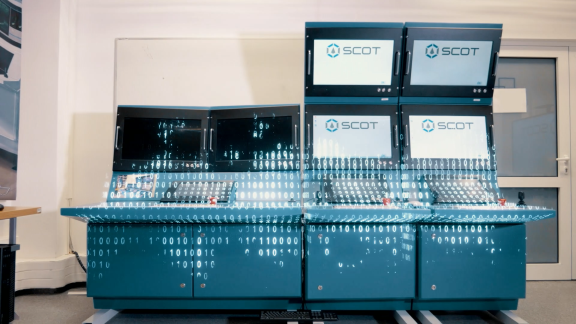SCOT - Polish Warship Systems Integration Capability

SCOT-M combat management system has been developed by the Polish OBR CTM entity, for the purpose of integrating sensors and effectors of the Kormoran II MCMV. This means that a basis for developing similar solutions for other vessels of the Polish Navy planned to be introduced into service has been founded at OBR CTM.
SCOT-M combat management system (Ship COmbat Tactical – Minehunter) is one of the least noticeable (looking from the outside) Polish solutions embedded within the Kormoran II minehunters. However, as it turns out, it is also one of the solutions that received a lot of appreciation, which may be proven by a number of awards that have been received, until now, by the OBR CTM facility. The awards concern both the ORP “Kormoran” as well as the SCOT system itself.
OBR CTM also received one of the “Amber Medallion” awards [Bursztynowy Medalion] for this system, during the Balt Military Expo event in Gdansk, back in June 2018. Presidential award for the SCOT suite, as a product that has been proven in increasing the level of safety of the soldiers, is even more important. It was presented during this year’s edition of the MSPO Kielce international defence industry exhibition in September. The distinction in question is even more valuable, as it was given during an event organized with a particular focus placed on the needs of the Air Force, Special Forces and Land Forces. Nonetheless, the competition has been won by a product that is decisively of a maritime profile, destined for the Polish warships.
The number of distinctions listed above means that ORP “Kormoran” MCMV has become one of the greatest successes achieved by the Polish defence industry in the recent years. Obviously, one may argue that some of the tactical and technical requirements defined by the Polish Navy were not established properly. However, the Polish shipyards and research facilities successfully accomplished the task assigned to them back in September 2013, meeting the Polish Navy’s requirements in full.

SCOT-M - What is it for?
SCOT-M combat management system is one of the greatest successes achieved during the Kormoran II programme. This suite integrates all effectors and sensors onboard the warship, allowing the crew to carry out the minehunting operations. And this solution has a decisive value for the warship’s combat potential and effectiveness. The task was fairly complicated, as it does not concern a single system, but rather, as the OBR CTM entity emphasizes, it refers to the “heart, brain and nervous system” of the vessel.
Cable and fibre optic connections are the nervous system of the ship. Almost all of the devices and systems are interconnected within that network. Information provided by sensors, concerning the observed situation, are received through this system, along with the data pertaining to the status of the monitored hardware. The system is also used to send control signals, not only ensuring proper functioning of the warship and accomplishment of the task, as these signals also remain crucial for the safety of the vessel.
Servers and local computers carrying out the computations, accumulating and recording the information, monitoring the subsystems and supporting the decisionmaking process act as the brain of the ship. The number of lines of code exceeding 3.2 million for the SCOT-M system software gives one a good overview of the system’s complexity.

BCI (CIC - Combat Information Centre) is the heart of the warship. There, all data is received and there it is being used to carry out the mission. CIC is where the integrated tactical image is compiled into a form understandable for the crew, on the basis of the data gathered by own sensors and external sources. The information often concerns the same objects, and the data needs to frequently rapidly associated, updated and correlated. SCOT-M needs to support the operators in the process of identifying and classifying the detected threats, and also when it comes to creating scenarios used to implement proper countermeasures. The tasks above are being carried out on the basis of continuously provided navigational, weather and ship-subsystems information.
CIC also acts as a location that may be used to remotely control practically the whole warship, including the engine room. Meanwhile, by using the radio communications systems, including satellite communications, at the CIC, one may also organize joint operations of the maritime groups, including allied ones.
SCOT-M: System Structure
By creating an integrated SCOT-M combat management system OBR CTM immediately assumed that the solution is not going to be developed solely for the Kormoran II class mine countermeasure vessels. Thus, a non-changeable portion of the system has been designated that, after introduction of minor modifications, could also be utilized on vessels of other classes. This is a layer that is tightly tied to cyber-security and, according to CTM, it remains responsible for joint national/coalition-based operations, information security and for fixed elements of the tasks carried out by the Polish Navy vessels.
The aforesaid portion of the system has been designed in a way that would make it possible to extend it with a “specialized” layer, characteristic for the given type, class or even example of a ship. In case of the Kormoran II minehunter the above includes a subsystem block for controlling the complementary UUV systems dedicated for minehunting operations. Thanks to the above the CIC operators, via the SCOT-M solution, may control as many as four types of underwater drones and robots onboard the Kormoran vessels. They may also receive status information and data provided by the onboard sensors by thos platforms.
This is required as the Kormoran II class CIC may accommodate up to 17 operators. Thanks to the SCOT system they may use all of the sensors and effectors available on the vessel, for the purpose of mission planning, search, classification, identification, mine countermeasures, decisionmaking support, task monitoring, reporting and training and simulation activities.
The standard scenario involving the Kormoran II vessel would involve initial detection that is carried out with the use of own hull-mounted sonar, remote controlled vehicle (Self Propelled Variable Depth SONAR) or HUGIN 1000 AUV, that is launched from the stern. The mine-reminiscing objects are then found with the use of hull-mounted sonar or underwater vehicles (SPVDS for instance). After the threats are classified, the objects are then identified, for instance with the use of the single-use mine countermeasure (Głuptak) or multiple use systems. Following a positive identification, mine neutralization process begins, whereas selection of a proper measure used for that purpose depends on the ship’s commander.
CIC makes use of mainly the multi-function consoles that may theoretically be utilized for any purpose, however the layout is divided into dedicated operator stations which facilitates crew integration and training. The CIC is divided into mine warfare/underwater weapons zone (six stations), battle command and tactical situation zone, communications and data transmission zone and a centrally placed CO station with an authorization panel.

Launching a dedicated MCMV “Laboratory for Integration of Warship Systems” was an important milestone in development of the SCOT-M solution. The laboratory replicates the entire CIC including the individual operator stations, be it real or computer-simulated ones. Thanks to the above it remains possible to test the relevant solutions before they are implemented on the warship. In this way, ability to carry out prior training of the ship crews has also been obtained. This is a mutual benefit since the Navy may immediately provide feedback to the company which, in turn, makes it possible to introduce early amendments in the offered solution.
The laboratory has thus become a place where software updates are tested, without a need to have the ship involved, and the warships themselves may be used operationally during that time. The laboratory is also a technology foundation for the Polish CIC systems designed to be fitted onto the new vessels.
SCOT-M is a result of a long-running research carried out by OBR CTM in this domain. Less complicated variants of SCOT have already been installed on Project 206FM and Project 207 minesweepers (“Pstrokosz” and “Bełtwa” systems). Numerous R&D works useful at the later stages were also launched, including: “Lodówka” (project 255 vessel and creation of a real-time system), “CARL 01”, “Pstrokosz-1”, “Gawron-Integracja”, “Wojownik-Integracja”, “CARL-02” and “LR-4K” implementation works and “Flaming-A” and “Flaming-B” scientific research initiatives. Developing a system at CTM for gathering, developing and distributing the mine situation information for the Mine Warfare Data Centre created as a part of the “Uhla” R&D initiative also played a relevant role here.
All of the above initiatives made it possible to create the ultimate form of the solution for the Kormoran MCMV. Active participation in the offset implemented by Thales was also quite important, according to OBR CTM. Integration of numerous armament systems was carried out for the OBR CTM centre, and the facility has been, consequently, deepening its knowledge and creating a proper team of people within that regard. Moreover, relevant software design management procedures were also introduced.
The Kormoran programme success are a good foundation for creating further SCOT systems for other vessels of the Navy. CTM has been carrying out similar tasks earlier on too, preparing the MGS1241 export solution for three small missile corvettes (1241RE, NATO codename: Tarantul I). Within the framework of this solution the Polish experts managed to integrate missile and artillery armament within a single shipborne C2 system.
